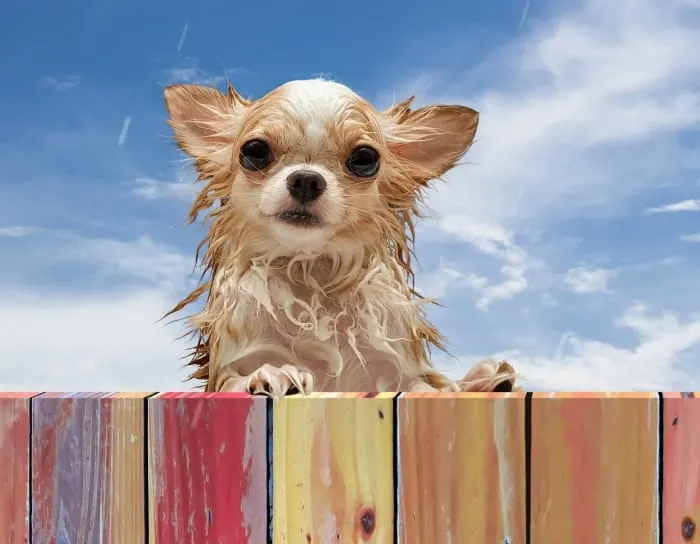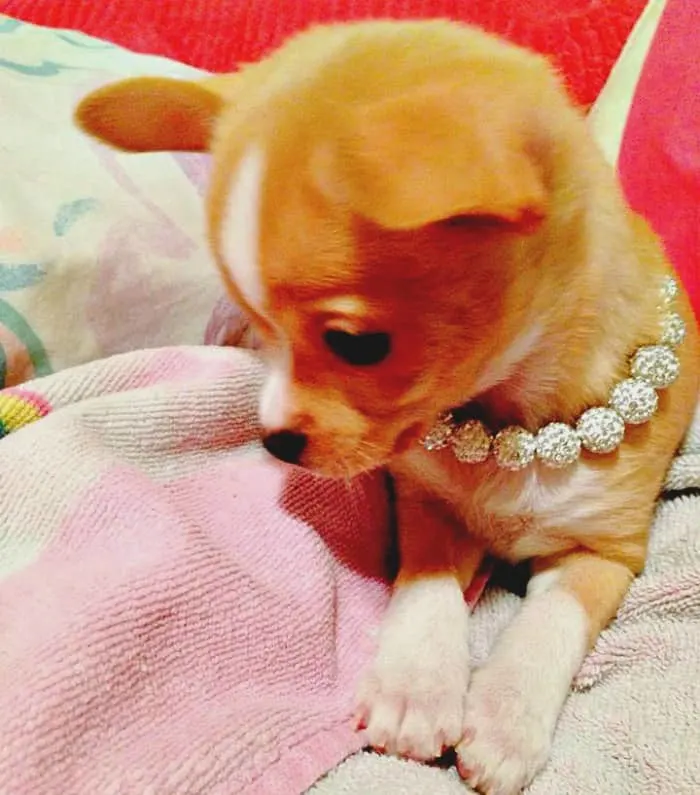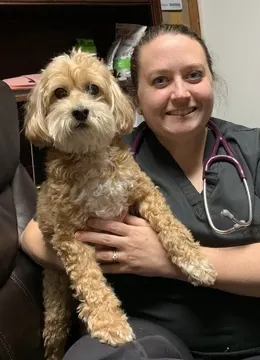Why Is My Dog So Stinky?

Has your dog ever had that certain doggy aroma? I know all of mine have at one time or another. Sometimes it’s as simple as you realize they are overdue for a bath. but sometimes it’s something more.
While Stinky Dogs come in a variety of sizes, shapes, and colors, I have found that the Cause of their stinkiness usually falls into one of two categories:
Self-Imposed Stinkiness – usually the result of normal dog activity.
Or
Medical Issue Stinkiness – usually the result of some ailment a dog has contracted.
In this Part, we will be discussing three common issues from the First category.
That Wet Dog Smell
Sniffing Out The Problem Whether your dog has been swimming in the ocean with you, running through the sprinklers with your children, or simply got caught in a sudden downpour out in your backyard, most owners have had the occasion to be introduced to that unmistakable Wet Dog smell … Whew!
The Cause The natural oil (called Sebum) that is produced by all dogs which gives them such a glossy coat while at the same time preventing their skin from drying out conspires with water to produce that smell.
In fact, it doesn’t matter if your dog has short hair or long hair for this to occur. Rather, it is the total surface area of all those thousands (if not millions) of dog hairs that your nose has to contend with.
While a dry dog still has the same overall smell, the combination of lots of water, dog hair (which can cling to moisture like a sponge), and even the slightest air flow can create a smell so pungent to be recognized worldwide.
 The Treatment Other than never letting your dog get wet again (which would include baths), your next best thing is to get your dog dry as quickly as possible. The following steps work pretty well:
The Treatment Other than never letting your dog get wet again (which would include baths), your next best thing is to get your dog dry as quickly as possible. The following steps work pretty well:
(a) Towel dry your dog to absorb most of the water. At this point, your dog will still be slightly damp.
(b) Pull out your dog’s brush and a good quality hairdryer and go to work. It would be best to have a smaller, quieter dryer so it doesn’t startle your dog.
(c) Utilize both the hairdryer and the brush to make sure you have sufficiently evaporated all of the excess water, but not so long as to dry out your dog’s skin. After all, that’s why the oil is there to begin with.
Things That Make Fido Go Flatulent
Sniffing Out The Problem Has this ever happened to you? You’re watching a movie in your favorite easy chair with your sweet little chihuahua by your side when the room suddenly fills with noxious fumes.
You glance down at your dog, pinch your nose shut with one hand, and quickly escort your dog outside with the other. How can such a small dog make such a stinky smell?
You have been the victim—albeit unintentionally – of a canine “silent but deadly” gas attack. More commonly known as a Fido Fart.
The Cause Although your dog may have gotten all the blame, let’s be honest, in the great majority of cases the gas problem is YOU. Yes, you! No, not in that “someone did IT but let’s blame the dog” way, but in one sense maybe that’s truer than you think.
To really understand, let’s talk about your dog’s digestive system.
Whether in a human or an animal, what is commonly referred to as a Fart (or Flatulence) is the result of a buildup of digestive gases being expelled from the body. The key is, that the harder the body has to work on digesting particular foods, the more gas is produced. For most people, beans are generally harder to digest than other foods and, as a result, the body produces more gas to expel shortly after eating beans.
So what does this have to do with your dog …
Because dogs are mostly carnivores by nature, most things that they eat that don’t fall in the “meat” category can (and often does) increases the chance that your dog’s digestive system will have problems digesting it, which, as we discussed, will lead to excessive gas buildup and eventually Doggy Farts.

So, why is this Your fault?
Let’s face it, if you find that your dog has recently become a bit gassier, more than likely, you gave him the food that produced the problem.
The Solution If your dog is relatively young and healthy and you find that doggy farts have been a recent occurrence, then it is important to identify what food is causing the problem and eliminate it from your dog’s diet.
Yes, I know your dog may look up at you with true puppy-dog eyes when you no longer share your favorite treat with him, however, unless you want to continue to keep your windows open in your house—even in the winter—you will need to be strong enough to resist the begging.
Be patient, though, after all, we all know how hard it is to give up the foods we love.
Important Note – If the gas problem persists even after you stop feeding your dog improper food, there may be something else wrong “under the hood” and so a trip to your vet may be in order. Just to be sure.
Stinky Dog Breath
Sniffing Out The Problem I think we can all agree that getting a snoot-full of pungent “doggy breath” is not high on anyone’s wish list. However, the fragrance of that Doggy breath can go a long way in determining if the underlying cause is a simple matter or something a lot more serious.
The Cause There are several basic things that can cause “Stinky Dog Breath” from tartar build-up on the teeth, an impacted tooth, bacteria build-up on the tongue, or even early signs of gum disease.
The Treatment In most cases, the best place to start is to pick up some dog formulated toothpaste (human toothpaste is not good for dogs) and make a habit of brushing your dog’s teeth.
This coupled with the purchase of either rawhide or nylon-based chew toys can go a long way in keeping the plaque and tartar in check.
There are even popular tongue cleaning products that will allow your dog to “lick” its way to cleaner breath. You can find a variety of ways of fighting doggy breath by checking out the shelves of your local pet store, searching the internet, or (even better) consulting with your vet for a good cleaning regiment to follow.
Ear Infection in Dogs
Sniffing Out The Problem You notice that your dog has been scratching at his ear or shaking his head more than usual. Upon investigating you detect a bad odor coming from his ear, and you begin to suspect that your dog may have an ear infection.
The Cause Dog ear infections are usually the result of debris or yeast becoming trapped inside the ear which can promote bacteria growth and eventually an ear infection. Mites can also cause ear infections. Once you suspect this your next step is to head straight to your vet’s office.
The Treatment Once in your vet’s office, your dog will be thoroughly examined. Unlike the human ear canal, which runs basically in a horizontal line, your dog’s ear canal is more vertical which can require special instruments to verify possible infections.
Using these instruments, your vet will take samples from the ear and check them to verify the type of infection your dog may have if any.
In most cases of infection, your vet will prescribe antibiotics or other drugs to clean up the infection which can come in the form of ear drops and/or oral medication.
Remember, it is very important to follow your vet’s instructions to the letter. Just like with humans, your dog may show signs of marked improvement before the prescribed treatment has a chance to completely destroy all of the bacteria resulting in a possible relapse. Your best bet is to finish treatment as instructed—including follow-up visits until your vet presents your dog with a clean bill of health.
After all, the last thing you and your dog need is to have to go through all of this hassle again because you tried a shortcut.
Yeast Infection on Dog’s Skin or Paws (“Frito Feet”)
Sniffing Out The Problem Yeast Infections tend to be relatively easy to detect using your nose. Owners who have had dogs with yeast infections have noticed a distinct odor that can remind them of “Frito s Corn Chips” coming from their paws which some owners have nicknamed ”Frito Feet”. Some others say that their dog’s skin has a smell like “moldy bread” or even “cheese popcorn”. Again, these smells definitely point to signs that your dog is suffering from a serious yeast infection.
The Cause All healthy dogs have both “good bacteria” and “yeast flora” on their skin which is maintained by a delicate balance of a healthy dog’s internal system.
However, if your dog consumes too much of the wrong foods, or is allergic to certain foods, it can throw off this delicate balance and like weeds in a garden, encourage the yeast flora on your dog’s skin to multiply unchecked.
Why does the yeast grow out of control, you may ask?
It’s because yeast needs sugars to grow, and sugars can come in many forms, such as sweet-tasting things, as well as carbohydrates like bread and pasta which break down into sugar. The more carbohydrates a dog is fed, the greater the risk of excessive yeast growth.
The Treatment The simplest thing an owner can do to prevent this is to monitor your dog’s diet. Remove as many carbohydrates from it as possible. By doing this, over time you should see a marked improvement in dogs with yeast infections while lessening the chances of your healthy dog getting a yeast infection.
Not to mention the other health benefits to your dog which comes from not eating a lot of carbs.
In addition, your dog can also benefit by adding some anti-fungal foods to his diet, such as oregano which has been shown to have beneficial properties in reducing the spread of the fungus, like yeast, over your pet’s body.
However, don’t forget that before you start any dietary regimen, you will never go wrong by consulting your vet first.
Following your vet’s advice, will soon have you and your dog both healthier and happier which is always the case when there is less “fungus among us”.
Anal (Sac) Gland Problems
Sniffing Out The Problem You notice that your dog is doing that butt scooting thing on the ground where they plop their rear end down, and then pull themselves across the floor with their front paws. In addition, you notice that this action also produces a very noticeable bad smell along this path.
The Cause Normally, when you view your dog from behind you will notice two ducts near the anal opening at approximately the “four” and “eight” o’clock position. These are your dog’s Anal Sacs or Glands which is what produces a fluid-like “scent” that normally is used to mark their “territory”.
In a healthy dog, during defecation, pressure is put on the anal sacs which allows your dog the ability to place his unique scent along with the deposited stool through the Sacs ducts.
However, for various reasons beyond the scope of this article, your dog’s glands/ducts can become either impacted (clogged up), infected, or both. The most common indicators that this has happened is if your dog is doing excessive licking or biting near the anal area, or the more common butt “scooting” that was already mentioned.
A most unpleasant odor is usually produced by this “scooting” as this action forces a large amount of “scent” out onto your floor or carpet.
The Treatment Once you suspect that your dog is suffering from this problem, a trip to the vet is warranted and it is usually treated in one of three ways:
(a) Cleaning out the clogged ducts leading to the gland. This procedure usually works well in relatively mild cases.
(b) Lancing the infected area – to relieve the problem by draining away the infection. This is usually accompanied by an antibiotic regimen to make sure the infection has been totally eliminated; Or
(c) Removal of the Anal Glands – If your vet finds it is warranted the Anal Glands can be removed which will prevent the problem from happening again.
No matter which procedure you and your vet agree on, the ultimate purpose will always be to relieve your pet’s pain and to do whatever is necessary to prevent the situation from happening again.
Special Note – Be aware that smaller breed dogs have a greater tendency of suffering from this ailment and should be checked more frequently to prevent a minor problem from becoming a major one.

A Very Important Note
While the above treatment is a good rule of thumb to start off with, you need to be aware that there is some doggy breath smells that can indicate a more serious condition than tartar build-up.
For example, if your dog’s breath smells like urine then it is possible that your dog is having kidney problems. On the other hand, if your dog’s breath is too sweet-smelling, it can indicate that your dog may have contracted diabetes.
If you suspect that your dog’s bad breath may be a result of something other than that piece of pizza you sneaked to him last night, then it would be best to set up an appointment with your vet to have him checked out.
While your suspicions may turn out to be unfounded, the earlier a suspected problem is checked out the greater the chance that, if something is wrong, a favorable solution will be found.
As always, remember that the goal is to keep your dog healthy and happy and there’s no better peace of mind than that.


Dr. Sara Ochoa
DVM
This article has been fact-checked and approved by Dr. Sara Ochoa DVM. You can read more about her on our About page.

my child is named banana
Wednesday 28th of July 2021
This is really helpful for my 9 yhear old child! Barbara xoxo
Cathy
Wednesday 28th of July 2021
I'm glad it is helpful to you Barbara!
Pet Blogger Showcase - December 3, 2016 | Heart Like a Dog
Saturday 3rd of December 2016
[…] Help! My Dog Stinks by Kilos Mom at I Love My Chi – Oh my. If you’ve ever been caught off guard by that SMELL coming from your dog, you’ll totally love this post. And also….Fido farts. You know I’m the Queen of the potty humor, but Fido Farts was a new one to me. […]
Jodi Stone
Thursday 1st of December 2016
I've been on the receiving end of the Fido fart and can tell you, it's no fun. :-) Most of the time it's not a continued problem, but when it becomes one, we go to the vet.
I'm actually going to check out some breath treats for the dogs, because they get a green lipped mussel and Sampson in particular has some pretty rank breath.
Thanks so much for this great post.
kilosmom
Thursday 1st of December 2016
You are welcome Jodi! Thanks for visiting!
Beth
Saturday 19th of November 2016
When I was teenager our Bullmastiff could clear the room with one of her silent, but deadly, farts. Thankfully, the food we feed our dogs now must agree with them, they rarely gas us out. Sophie had terrible breath, but it has cleared up since she had a cracked tooth removed.
kilosmom
Saturday 3rd of December 2016
I can imagine a fart from a large dog like a Bullmastiff must be quite potent.
Jan K
Saturday 19th of November 2016
Great post - it's important to know that some of those smells we might think are normal dog smells could actually mean there's a bigger problem. I'm generally lazy so I'd rather just put up with the "wet dog smell" for a while, than bother to get out a blow dryer! I usually just have a good quality microfiber towel (I like the Luv & Emma's that we can hang right by the door) on hand to dry them as well as possible.
kilosmom
Saturday 3rd of December 2016
I haven't heard of Luv & Emma's before. I'll have to look into it.